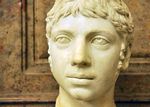Heliogabalus
| Anon. (1588?) | 
| |
| Bust of Heliogabalus |
Historical Records
On 19 June 1594, the following entry was made in the Stationers' Register: "an other enterlude of the lyfe and deathe of Heliogabilus." John Danter paid the fee to enter the play.
Theatrical Provenance
The entry in the Stationers' Register gives no clue to company ownership or theatrical venue (For What It's Worth, below). If the reference by Robert Greene to Heliogabalus is to the lost play, it was most likely on stage in the same time frame as Marlowe's two-part Tamburlaine c . 1588 (References to the Play, below).
Probable Genre(s)
Classical Tragedy
Possible Narrative and Dramatic Sources or Analogues
Heliogabalus, born Varius Avitus Bassianus c. 203 CE (also called Antoninus or young Antoninus; also, Sardanapalus), ruled from 218 to 222 CE. He was well known in the works of Roman historians and Elizabethan moralists for his extreme and perverse religiousity, reign of terror, and debauchery. He acquired the name, Elagabalus, or Heliogabalus, for his worship of the Syrian sun god of that name; when he became emperor, he promoted the rites of Elagabalus over those of Jupiter. He was killed by his own Praetorian Guard.
Selected Roman Sources
- Herodian (c. 170-240 CE), History of the Roman Empire Since Marcus Aurelius (Book V livius.org)
Herodian emphasizes the actions by Heliogabalus to supplant the worship of traditional Roman gods with that of the Syrian sun god, Elabagalus. He had himself been raised as a priest of this god, and Herodian implies that some of Heliogabalus' dress and behavior stemmed from perverse religious rites. Heliogabalus wore silk robes of an effeminate style, used women's make-up, and "danced around the altars to music played on every kind of instrument" (V.5). This style so unRoman that he had a large picture of himself dressed in his favorite garb set up in the Roman Senate House so that officials would become familiar with his looks (V.5). Heliogabalus himself married three times, and he married his sun god to the moon goddess, Urania (V.6). He staged lavish spectacles with animal sacrifice, tossing gifts wantonly to the crowds who then trampled one another to grab the rewards (V.6). In one festival, Heliogabalus rigged a chariot drawn by six large white horses; in the chariot was a statue of the god, looking as if he held the reins. Heliogabalus ran backwards in front of the chariot with the actual reins in his hands. The streets were strewn with sand laced with gold so that he had better purchase as he ran, and "bodyguards supported him on each side to protect him from injury" (V.6).
Herodian's secondary focus is Heliogabalus's promotion of underlings including "charioteers, comedians, and actors of mimes" to positions of power (V.7).
Two women—his grandmother and mother—attempted to molify public opinion against Heliogabalus's excesses, but they were unable in the end to prevent his being attacked along with his followers and killed; "when the bodies had been dragged throughout the city, the mutilated corpses were thrown into the public sewer which flows into the Tiber" (V.8).
- Cassius Dio (c . 155-229 CE), Roman History www.livius.org
- Historia Augusta www.livius.org
Selected Sixteenth-Century English Commentators
- Thomas Elyot
- George Whetstone
- Richard Rainolde
- Richard Robinson
References to the Play
Robert Greene, in the preface to Peremedies the Blacke-Smith (1588), complains about "two Gentlemen Poets, made two mad men of Rome beate it out of their paper bucklers: & [who] had it in derision, for that I could not make my verses iet vpon the stage in tragicall buskins, euerie worde filling the mouth like the faburden of Bo-Bell, daring God out of heauen with that Atheist Tamburlan, or blaspheming with the mad preest of the sonne .... " (A3).
Critical Commentary
E. K. Chambers W. W. Greg Charles Nichol Tom Rutter Greene scholars?? Knutson, "Naming of Parts"
For What It's Worth
- Source material:
In the Roman History of Cassius Dio, Heliogabalus is called "Sardanapalus," confusing him thus with a semi-fictional king of Assyria. Gutenberg In sixteenth-century commentators, the mythical king (Sardanapalus) and the historical emperor (Heliogabalus) are more frequently separate figres but cited, often together, as similarly debauched.
- Contemporary circumstances:
Earlier on the same day of 19 June 1594 that he entered "Heliogabalus," John Danter entered the play of "Godfrey of Boulogne," with the following phrasing: “an enterlude entituled Godfrey of Bulloigne wth the Conquest of Ierusalem.” One week after the entry in stationers records (19 July), the Admiral's men introduced "Godfrey of Boulogne, Part 2", marked "ne"; a play consistently designated "Godfrey of Boulogne" without a mark of "ne" was introduced a week later (26 July). The coincidence of Danter's having "Godfrey of Boulogne" and "Heliogabalus" on 19 June 1594 allows the possibility that he acquired the two plays from the same source. The fact that "Godfrey of Boulogne" was not marked "ne" suggests that Danter's source was a playing company, but which one that might have been is unknown.
Works Cited
Site created and maintained by Roslyn L. Knutson, Professor Emerita, University of Arkansas at Little Rock, 11 February 2011.